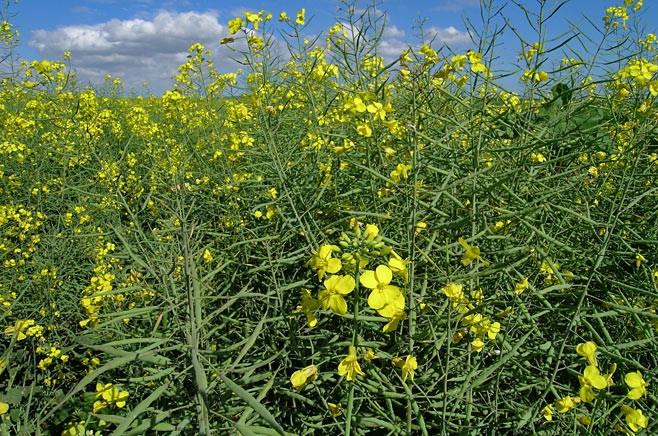|
Brassica napus (Rape, Oilseed rape, Canola) Life
> eukaryotes >
Archaeoplastida >
Chloroplastida
>
Charophyta > Streptophytina > Plantae (land plants)
> Tracheophyta (vascular plants) > Euphyllophyta > Lignophyta (woody plants)
> Spermatophyta (seed plants) > Angiospermae (flowering
plants) > Eudicotyledons > Core Eudicots > Rosids >
Eurosid II > Order: Brassicales > Family: Brassicaceae > Genus:
Brassica
 |
|
Canola crop, in fields north of Durbanville,
Western Cape. [photo H. Robertson, Iziko ©] |
Brassica napus is native to Eurasia and has a number
of varieties that are cultivated widely round the world for the production of
vegetable oil. Natural rapeseed contains high concentrations of erucic acid and
glucosinolates, both of which are substances that are not healthy if eaten in
large amounts although their exact health effects (positive and/or negative) are
not altogether clear. Erucic acid is used in oil paints and for transmission
oils and varieties of rapeseed with high erucic acid are cultivated for this
market. Canola is a variety of Brassica napus developed in Canada that
contains low concentrations of erucic acid and glucosinolates and the name is
derived from the words CAnadian Oilseed Low_Acid. It is grown
mainly for the production of cooking oil and Canola margarine and has been
cultivated in South Africa since 1994. A transgenic variety of Canola has been
produced that enables farmers to spray the herbicide Roundup to control weeds
without adverse affects to the oilseed plant. There has been a controversy over
the ability of such transgenic varieties to crosspollinate with wild species
similar to Brassica napus that grow in the vicinity of the crops.
Links
References
-
McGeoch, M.A., Kalwij, J.M. and Rhodes, J.I. 2009. A
spatial assessment of Brassica napus gene flow potential to wild and
weedy relatives in the fynbos biome. South African Journal of Science
105: 109-115.
|
